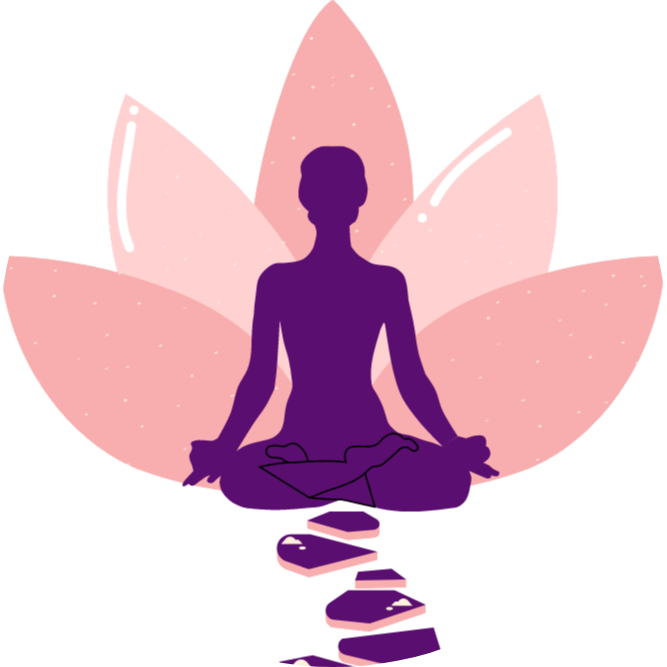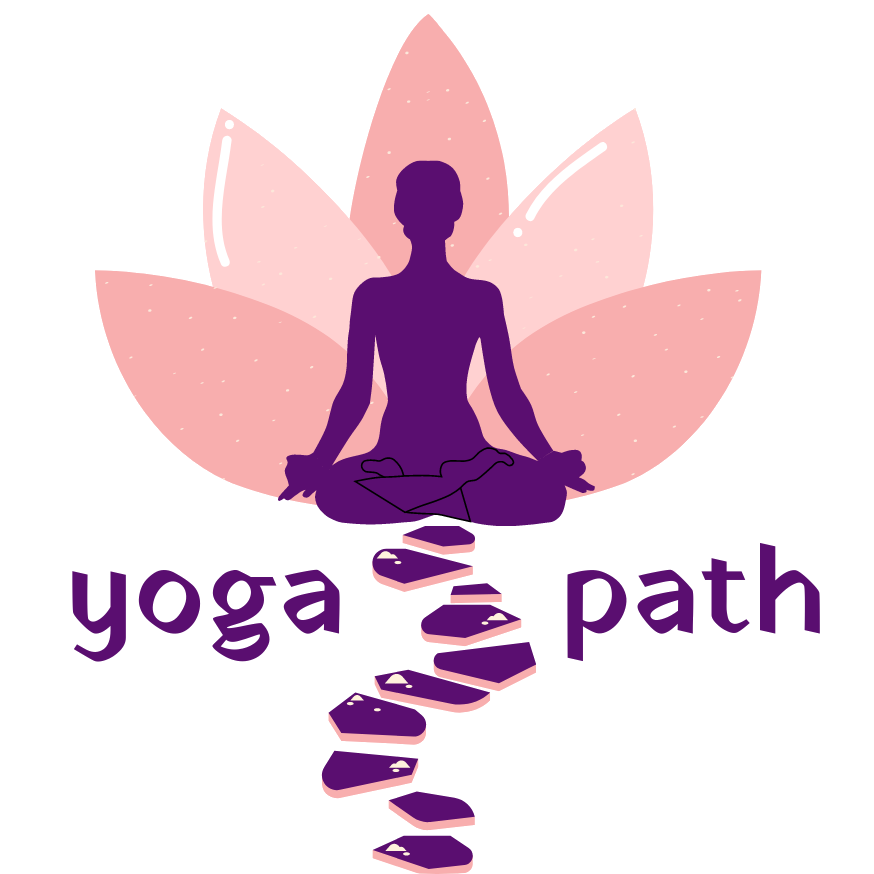Practise Yoga Asanas
Learn Asanas - Supine Poses
Supine Asanas are poses performed while lying flat on our back with our faces up. These are adaptable, calming postures that help to relieve stress, increase flexibility, and strengthen the back and digestive system.
Supine poses require a lot of effort, so you should take a 30-second break after you finish them. Take time to rest in Shavasana or corpse pose at the end of a set of Supine poses.
Supine asanas include poses such as Pawanmuktasana, Supta Vakrasana, Ardha Halaasana, Viparit Karni and Shavasana.
Matsyasana
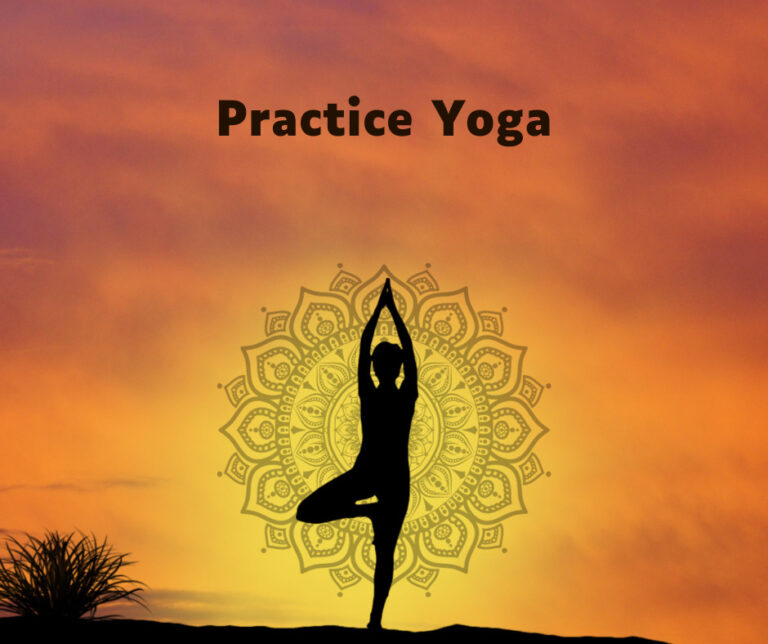
Supine Pose – Lying down with backward bending
Matsya Asana meaning the Fish pose.
In this asana, lie on your back, with feet together and hands relaxed alongside the body. Place the hands underneath the hips, palms facing down. Bring the elbows closer toward each other.
Inhaling lift the head and chest up.
Keep the chest raised and expanded, lower the head backward and touch the top (crown) of the head to the floor, placing the weight on the elbow.
Press the legs to the floor. Hold the pose for 6 seconds to 1 minute. Relax and breathe deeply.
Lift the head up, lower the chest and head to the floor. Bring the hands back along the sides of the body. Relax.
Contraindications:
High or low blood pressure, Migraine and insomnia, serious lower-back or Neck injuries.
Benefits:
Stretches the chest and neck.
Helps relieve tension in the neck and shoulders.
Expands lungs and improves respiratory system.
Tones the parathyroid, pituitary and pineal glands.
Heals reproductive disorders.

Supine Position
Purvottanasana, the meaning of Purva is ‘East’, uttan is ‘stretch’. This is the reverse pose of simple plank pose. The Purvottanasana means an extreme eastside stretch. East means the front of the body
First get into Dandasana sit on mat with legs together and outstretched in front.
Keep your hands behind your hips, so that your fingertips are facing towards your hips.
Now bend your knees, place the soles of your feet on the floor hip-width apart.
Exhale and push your hands and feet strongly onto the ground as you lift your hips and abdomen up. Keep your arms straight at the elbows. With the help of your spinal muscles straighten your legs from the knees as well and point your toes out. Raise your hips as high as possible, and keep your glutes and legs firm and strong. Now raise your chest up as well and shoulders up, allow your head to slowly hang behind as you look up. Remain in the pose about 5 to 6 breaths. Exhale as you lower down your body and get into the initial pose.
Repeat this process around 3 to 5 times.
Contraindications:
Refrain if you have an injury at the wrist, neck, or back. People with high blood pressure should never perform it without supervision. Those with severe migraine, carpel tunnel syndrome must not perform this pose.
Benefits:
Stretches the chest, shoulders, biceps and the front of your ankles.
Strengthens your, arms, legs, core and back.
Excellent counterpose for plank – staff pose.
Strengthens your arms, wrists, hamstrings and glutes.
Good therapeutics for depression or fatigue and relaxes your mind.
Viparit Karni

Supine Pose – Lying down with legs up against a wall
The pose described here is a passive, supported variation of the shoulder stand-like Viparit Karni. You’ll also need to rest your legs vertically on a wall or similar upright support.
Sit sideways with your right side against the wall, lie down lowering your back and head on the floor.
Exhale and, slowly slide your legs up onto the wall sideways while your back, shoulders and head are down on the floor.
Lift and release the base of your skull away from the back of your neck and soften your throat. Don’t push your chin against your sternum.
Open your shoulder blades away from the spine and release your hands and arms out to your sides, palms up.
Keep your legs straight. Feel the weight of your legs and belly deeply into your torso, toward the back of the pelvis. Soften your eyes and turn them down to look into your heart.
Stay in this pose for 1 minute you can increase to 15 minutes. Then bend your legs, and turn to the side.
Stay on your side for a few breaths, and come up to sitting with an exhalation.
Contraindications:
Glaucoma and serious eye problems, Back injury or problems or Neck injury or problems. Not to be done during Menstruation.
Benefits:
Helps ease Anxiety, mild Depression and calms the mind.
Heals Migraines, Headaches, Arthritis, Digestive problems, High and low blood pressure, Respiratory ailments, Uinary disorders, Varicose veins, Piles, Fissures and relaxes cramped legs and feet and reduces Insomnia.
Benefits circulation in the lower back and the abdomen region and its internal organs.
In women, it eases Menstrual cramps, Premenstrual syndrome and Menopause.
Benefits as described in Yoga Philosophy:
- “You will become adept in all the worlds and will not perish even at world dissolution (pralaya)” – Gheranda Samhita 3.36
- Hatha Yoga Pradipika 3.82 states grey hairs and wrinkles reduce
Setubandasana
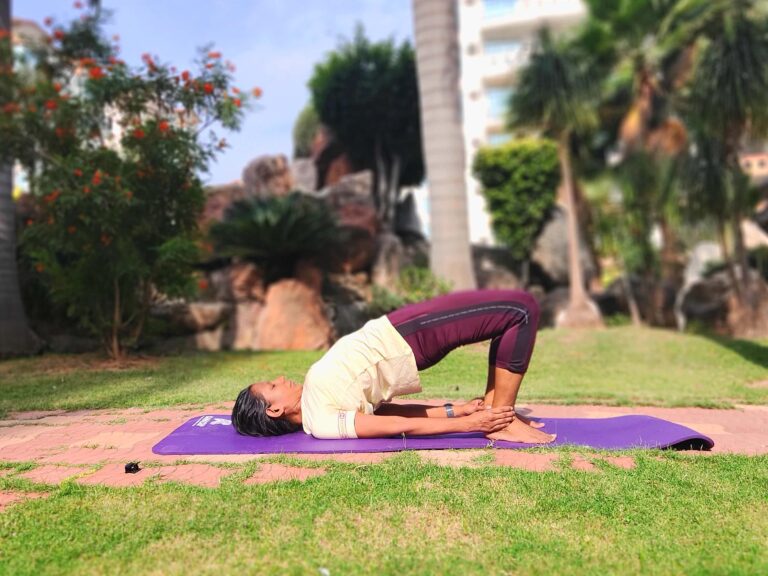
Supine Asana
Setu meaning Bridge; Bandha meaning Bind or Lock;
To begin, lie on your back. Fold your knees and keep your feet hip distance apart on the floor, close to your pelvis, with knees and ankles in a straight line.
Place your palms on your ankles. Inhaling, slowly lift your lower back, middle back and upper back off the floor; gently roll the shoulders inwards; raise the chest to the chin supporting your weight with your shoulders, arms and feet.
Both the thighs are parallel to each other and to the floor. Hold this pose for few breaths. exhale as you gently release the pose.
Contraindications:
Neck injuries, Shoulder or back injuries or surgery, Hypertension, Heart ailments, Myopia and Glaucoma or retinal detachment.
Benefits:
Strengthens the back muscles
Relaxes back instantaneously
Gives a good stretch to the chest, neck and spine
Opens up the lungs and reduces thyroid problems
Strengthens glutes and quadriceps
Calms the brain, reducing anxiety, stress and depression
Helps improve digestion
Helps relieve the symptoms of menopause and menstrual pain
Helpful in asthma, high blood pressure, osteoporosis, and sinusitis
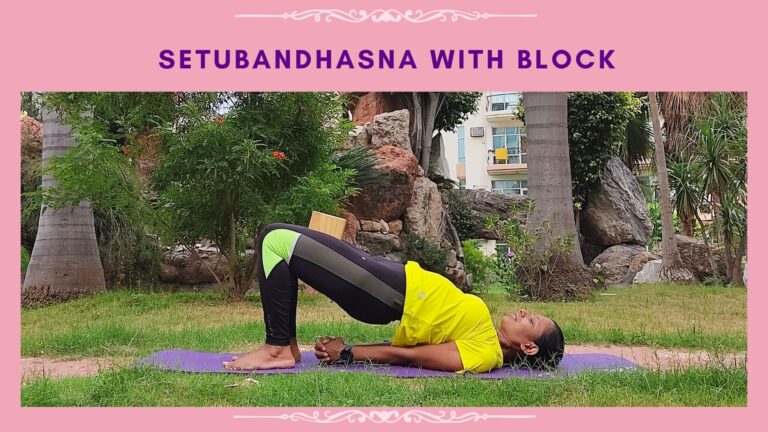
Supine Position
Setu meaning Bridge; Bandha meaning Bind, Lock. This is a variation using a block.
To begin, lie on your back. Fold your knees and keep your feet hip-distance apart on the floor, close to your pelvis, with knees and ankles in a straight line.
Place your palms on your ankles.
Hug a block between your inner thighs. Keeping your feet parallel and hip-distance apart, place a block at its most narrow width between your inner thighs.
Inhaling, gently roll the shoulders inwards; raise the chest to the chin supporting your weight with your shoulders, arms and feet Now, slowly lift your lower back, middle back and upper back off the floor. Lightly squeeze the block as you lift into Bridge Pose.
This keeps your knees in line and buttocks softer; you might notice it feels better in your lower back too.
Hold this pose for a few breaths. exhale as you gently release the pose.
Contraindications:
Neck injuries, Shoulder or Back injuries or surgery, Hypertension, Heart ailment, Myopia and glaucoma or retinal detachment.
Benefits:
Strengthens the back muscles.
Relaxes the back instantaneously.
Gives a good stretch to the chest, neck and spine.
Opens up the lungs and reduces thyroid problems.
Strengthens glutes, quadriceps and calves.
It cures leg fatigue and prevents varicose veins.
Calms the brain, reducing anxiety, stress and depression.
Helps improve digestion.
Helps relieve the symptoms of menopause and menstrual pain.
Helpful in asthma, high blood pressure, osteoporosis, and sinusitis
Gives relief from migraines headaches insomnia and exhaustion.
Pressing the block benefits:
– Strengthens adductors and abductors (inner and outer thigh muscles). In turn, this strengthens the knees.
– Strengthens deep lower belly transverse abdominus muscles.
– Also strengthens the glutes and the pelvic muscles.

Supine Pose
Ardha means half, Hala means plough; so this is the Half Plough Pose
Lie down on the mat on your back (supine position).
Join both the legs and keep arms by your side. Slowly breathe in and raise the leg perpendicular to the ground keeping the knee straight and the feet flexed with toes pointing towards the face and heel pointing backwards.
Breathe in and out and stay in this position as long as possible.
Breathe out and lower your legs. relax for a while.
Repeat the same for 3 to 5 times.
The above mentioned technique can also be performed only with a single leg one after the other.
Contraindications:
People suffering from any Cardiac problem, Back pain, High blood pressure should avoid this practice.
Benefits:
Improves digestion and appetite.
Improve blood circulation.
Strengthens the hip, thigh muscles and calf muscles, which in turn strengthens the knee and improves joint mobility.
Helpful to reduce abdomen fat and lose weight.
Very good massage and circulation to the pelvic region.
Strengthens the pelvic floor muscles and supports the uterus.
Stimulates the abdominal organs and strengthens the core muscles
Helps relax and massage the lower back
Helps relieve the swelling and improves varicose veins
Expels gas, improves kidney and liver function and promotes production of digestive enzymes.
Therapeutic application of Ardha Halasana:
Indigestion, Constipation, Obesity, Urinary disorders
Supta Vakrasana

Supine Position – Spinal torsion
Lie down on your back on the mat, legs stretched forward and hands by the sides Stretch the arms out, perpendicular to the body in a T.
Now, fold the legs at the knees and draw the feet in. Keep the feet and knees together, perpendicular to the floor. Inhale normally. Exhaling, in gently let the legs fall together to the left, to allow the knees to rest on the floor with both knees one above the other. Simultaneously, turn the neck to the right, to gaze at the right thumb.
Hold this pose for few seconds, with the breath suspended. Move the legs raising the knees back up while inhaling. Without a pause, exhaling, in 3 seconds, repeat the above steps to the right, to complete 1 round.
Contraindications:
Severe back pain, Abdominal inflammations, Ulcers and Sciatica.
Benefits:
Exercises and relaxes the spinal muscles
Gently exercises the abdominal and back muscles
Helps alleviate chronic back and shoulder pain
Lower back – strengthens muscles, relieves stiffness and alleviates pain
Improves digestion and combats constipation
Trims the waist line and reduces abdominal fat
Improves functioning of thyroid and muscles of eyes

Supine / Lying down Asana
Pawan meaning gas, Mukta meaning releasing. Pawanmuktasana is an anti-flatus pose, excellent for releasing gas.
In this asana, lie supine at full length on a mat, feet together and hands resting beside the body. Relax mind and calm and body. Inhale normally.
Exhaling in 3 seconds, bend both the legs at the knee and draw it towards the abdomen. Wrap the forearms just below the knee (the fingers clasping the opposite elbows), and keep it firmly pressed against the chest. Ensure to rest the head and neck on the floor.
Maintain this pose for 6 seconds. Inhaling, in 3 seconds, gently release the clasped hands and slowly straighten the leg to bring it back to the starting position. You can hold position for 30 seconds and increase to 2 minutes.
Contraindications:
Abdominal inflammation, Cardiac conditions, Hernia, Piles, Menstruation and Pregnancy.
Benefits:
This posture gives significant relief to flatulence by quickening the movement and expulsion of the intestinal flatus.
Favourable improvement in cases of flabby abdomen, sub-normal functions of the abdominal viscera and pelvic organs.
Relief in case of chronic constipation and sluggish liver.
It sharpens the brain, improves concentration, calms you and reduces mental problems.
Shoulder muscles, triceps, gluteus maximus and hamstrings are stretched.
Offers deep internal pressure massage.
Inculcates a feeling of “letting go”.
